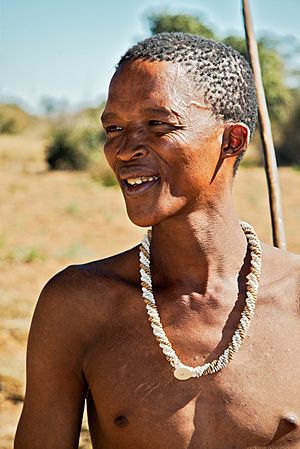Hunter-gatherer facts for kids

A hunter-gatherer society is a group of people who get their food directly from nature. They find edible plants and animals in the wild. This means they spend their time foraging for things like berries, roots, and nuts, and hunting animals for meat.
The difference between hunter-gatherers and other groups, like farmers, is not always clear. Some nomadic people might hunt and gather, but also herd animals. Others might spend some time farming and some time foraging. For most of human history, everyone lived as a hunter-gatherer.
Contents
Life in a Hunter-Gatherer Society
For thousands of years, hunter-gatherers lived by moving from place to place. They followed animal herds and found plants that were ready to eat. This way of life meant they had to be very skilled at understanding their environment.
Finding Food: Hunting and Foraging
Hunter-gatherers were experts at finding food.
- Hunting: Men often focused on hunting larger animals like deer, bison, or even mammoths in the past. They used simple weapons like spears, bows and arrows, or traps. Hunting provided protein and fat, which were important for energy.
- Foraging: Women and children usually gathered plants. This included fruits, berries, nuts, roots, and seeds. They knew which plants were safe to eat and where to find them. Foraging often provided a more reliable food source than hunting.
Tools and Technology
Hunter-gatherers used simple but effective tools made from natural materials.
- Stone Tools: Early humans made sharp tools from stone for cutting meat, scraping hides, and preparing plants.
- Wood and Bone: They also used wood for spears and digging sticks, and bone for needles and other small tools.
- Fire: The ability to control fire was a huge step. Fire provided warmth, protection from animals, and a way to cook food, making it safer and easier to digest.
Moving Around: A Nomadic Lifestyle
Most hunter-gatherer groups were nomadic. This means they did not stay in one place for long. They moved to new areas when food became scarce or when seasons changed. Their homes were often temporary shelters, like tents or simple huts, that could be easily set up and taken down. This allowed them to follow the migration of animals or find new patches of ripe plants.
Small Groups and Sharing
Hunter-gatherer societies usually lived in small groups, often called bands or tribes. These groups were typically made up of a few families, maybe 20 to 50 people. Everyone in the group worked together to find food and survive. Sharing was very important. If a hunter caught a large animal, the meat would be shared among everyone in the group. This helped ensure that everyone had enough to eat, especially during difficult times.
The Shift to Farming
About 10,000 years ago, some groups of hunter-gatherers started to change their way of life. They began to plant seeds and raise animals, leading to the development of agriculture or farming. This change is known as the Neolithic Revolution. Farming allowed people to stay in one place and produce more food than they could gather or hunt. This led to larger settlements and eventually, the first cities.
However, some groups continued to live as hunter-gatherers. They adapted to different environments, from dense forests to vast deserts.
Hunter-Gatherers Today
Today, very few people live solely as hunter-gatherers. Most have adopted farming or other modern ways of life. However, some groups still practice traditional hunting and gathering, often in remote parts of the world. Examples include:
- The San people of Southern Africa.
- Some Pygmy groups in Central Africa.
- Certain Indigenous Australian communities.
- The Inuit people in the Arctic regions.
Studying these groups helps us understand how our early ancestors lived and how humans adapted to different environments for thousands of years.
Related pages
Images for kids
-
Pygmy hunter-gatherers in the Congo Basin in August 2014.
-
A 19th-century engraving of an Indigenous Australian encampment.
-
A Shoshone encampment in the Wind River Mountains of Wyoming, photographed in 1870.
-
Three Aboriginal Australians on Bathurst Island in 1939.
See also
 In Spanish: Caza y recolección para niños
In Spanish: Caza y recolección para niños







